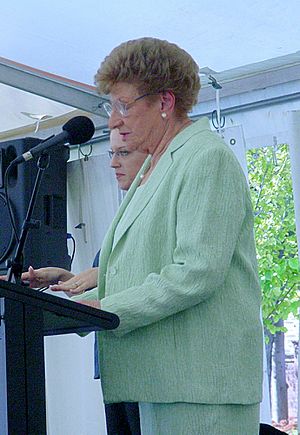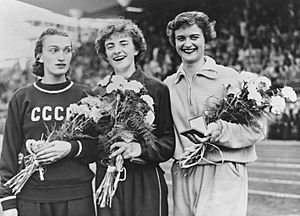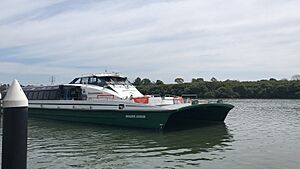Marjorie Jackson-Nelson facts for kids
Quick facts for kids
Marjorie Jackson-Nelson
|
||||||||||||||||||||||||||||||||||||||||||||||||||||||
|---|---|---|---|---|---|---|---|---|---|---|---|---|---|---|---|---|---|---|---|---|---|---|---|---|---|---|---|---|---|---|---|---|---|---|---|---|---|---|---|---|---|---|---|---|---|---|---|---|---|---|---|---|---|---|

Marjorie Jackson-Nelson in 2007
|
||||||||||||||||||||||||||||||||||||||||||||||||||||||
| 33rd Governor of South Australia | ||||||||||||||||||||||||||||||||||||||||||||||||||||||
| In office 3 November 2001 – 8 August 2007 |
||||||||||||||||||||||||||||||||||||||||||||||||||||||
| Monarch | Elizabeth II | |||||||||||||||||||||||||||||||||||||||||||||||||||||
| Premier | Rob Kerin (2001–02) Mike Rann (2002–07) |
|||||||||||||||||||||||||||||||||||||||||||||||||||||
| Preceded by | Sir Eric Neal | |||||||||||||||||||||||||||||||||||||||||||||||||||||
| Succeeded by | Kevin Scarce | |||||||||||||||||||||||||||||||||||||||||||||||||||||
| Personal details | ||||||||||||||||||||||||||||||||||||||||||||||||||||||
| Born | 13 September 1931 Coffs Harbour, New South Wales, Australia |
|||||||||||||||||||||||||||||||||||||||||||||||||||||
| Spouse |
Peter Nelson
(m. 1953; died 1977) |
|||||||||||||||||||||||||||||||||||||||||||||||||||||
|
||||||||||||||||||||||||||||||||||||||||||||||||||||||
Marjorie Jackson-Nelson, born on September 13, 1931, is a famous Australian athlete and former politician. She was the Governor of South Australia from 2001 to 2007. During her amazing sports career, she won two Olympic gold medals and seven Commonwealth Games gold medals. She also set six individual world records. From 1950 to 1954, she won every Australian state and national title she competed for.
Contents
Early Life and Training
Marjorie Jackson was born in Coffs Harbour, New South Wales. Her family later moved to Lithgow because her father worked at a rifle factory during World War II. When she was thirteen, her mother became sick, and Marjorie had to help run the house.
Discovering Her Talent
In school, Marjorie started winning local races. People nicknamed her "Bernborough" after a famous racehorse. At fifteen, she went to Sydney for the national championships. She won every race she entered there. She joined the South Sydney Athletics Club. She was invited to try out for the 1948 Summer Olympics. However, she thought the race started too early and stayed in the starting blocks. Because of this, she missed her chance to go to the Olympics.
Training Hard
Marjorie worked as a typist but kept training as an athlete. She ran on the Lithgow Oval. The town even built her a special cinder track. Her father bought her track spikes and built her starting blocks. Marjorie trained at night. Her coach, Jim Monaghan, used his car headlights to light up the track for her.
Amazing Athletic Career
In 1949, a famous Dutch athlete named Fanny Blankers-Koen visited Australia. Marjorie raced against her three times and won every race. In their last race, officials cut the grass shorter in Blankers-Koen's lane. Even so, Marjorie won and beat an Olympic record. In January 1950, Marjorie set her first world record. She ran 100 yards in 10.8 seconds in Adelaide. From 1950 to 1954, she won every state and national title in the 100 yards and 220 yards. People called her "The Lithgow Flash" because of her speed and where she grew up.
1950 British Empire Games
Marjorie competed in the 1950 British Empire Games in Auckland, New Zealand. She won four gold medals there. These included the 100 yards, 200 yards, and two relay races. She was part of the 3 × 110/220 yards relay and the 4 × 110/220 yards relay teams.
1952 Summer Olympics Success

After her success in 1950, Marjorie was a favorite for the 1952 Summer Olympics in Helsinki. On the plane to Helsinki, she met fellow Australian Olympian Peter Nelson. She won a gold medal in the 100 meters. She equaled the world record time of 11.5 seconds. She won by almost four meters, which was the biggest winning gap in Olympic women's 100 meters history.
In the 200 meters, Marjorie set new world records in the heats and semi-finals. She then won the gold medal with a time of 23.7 seconds.
Relay Race and Records
Marjorie was the last runner in the Australian 4 × 100 meters relay team. The team set a world record in their first race. They were expected to win the final. But during the last handoff, Marjorie accidentally dropped the baton. The American team won instead, setting a new world record. The Australian team finished fifth.
Marjorie was the first Australian woman to win an Olympic gold medal in athletics. She was also the first Australian to win an Olympic athletics gold since 1896. A song called "Our Marjorie" was even written about her. When she returned from Helsinki, she rode in an open-top car for over 150 km to Lithgow. In October 1952, she broke the 100 meters world record again in Japan. She was named The Outstanding Athlete of 1952.
1954 Commonwealth Games and Retirement
Jackson-Nelson competed at the 1954 Commonwealth Games in Vancouver, Canada. She won three more gold medals there. These were for the 100 yards, 220 yards, and the 4 × 110 yards relay. After these Games, at age 23, she decided to retire from athletics. She wanted to focus on her marriage.
Life After Athletics
Marjorie Jackson-Nelson became involved in sports management. She was the first female manager of a multi-sport team for Australia at the 1994 Commonwealth Games. She also helped the Australian teams for the 1996 Olympic Games and the 1998 Commonwealth Games. She was on the board for the Sydney Organizing Committee for the 2000 Summer Olympics. She was also one of the eight people who carried the Olympic Flag at the opening ceremony. A road at Sydney Olympic Park is named after her.
Governor of South Australia
In late 2001, Jackson-Nelson was chosen to be the Governor of South Australia. She held this important job until July 31, 2007.
In 2006, she was one of the final four runners to carry the Queen's Baton around the stadium during the 2006 Commonwealth Games Opening Ceremony in Melbourne. In 2007, a new hospital was planned to be named the "Marjorie Jackson-Nelson Hospital." However, in 2009, she asked for her name not to be used for the hospital.
Personal Life
Marjorie married Peter Nelson on November 7, 1953. They moved to Adelaide and had three children. Peter continued his cycling career. Sadly, he was diagnosed with leukemia at 45. Marjorie cared for him for 22 months until he passed away in 1977. That same year, she started the Peter Nelson Leukemia Research Fellowship Fund. Her goal was to help find a cure for leukemia.
Awards and Recognition
Marjorie Jackson-Nelson has received many honors for her achievements:
- 1953: She became a Member of the Order of the British Empire (MBE) for her service to women's athletics.
- 1985: She was inducted into the Sport Australia Hall of Fame.
- 2001: She received the Companion of the Order of Australia (AC) when she became governor.
- 2001: She was added to the Victorian Honour Roll of Women.
- 2002: She became a Commander of the Royal Victorian Order (CVO) during Queen Elizabeth II's visit to South Australia.
Jackson-Nelson was also given the Olympic Order. This is the highest award from the International Olympic Committee. She received it in Beijing in 2008. She is also a Dame of the Order of St John of Jerusalem. In 1993, a Sydney RiverCat ferry was named "MV Marjorie Jackson" after her. The "MV Marjorie Jackson" ferry was retired from service in June 2025.
See also
 In Spanish: Marjorie Jackson para niños
In Spanish: Marjorie Jackson para niños


